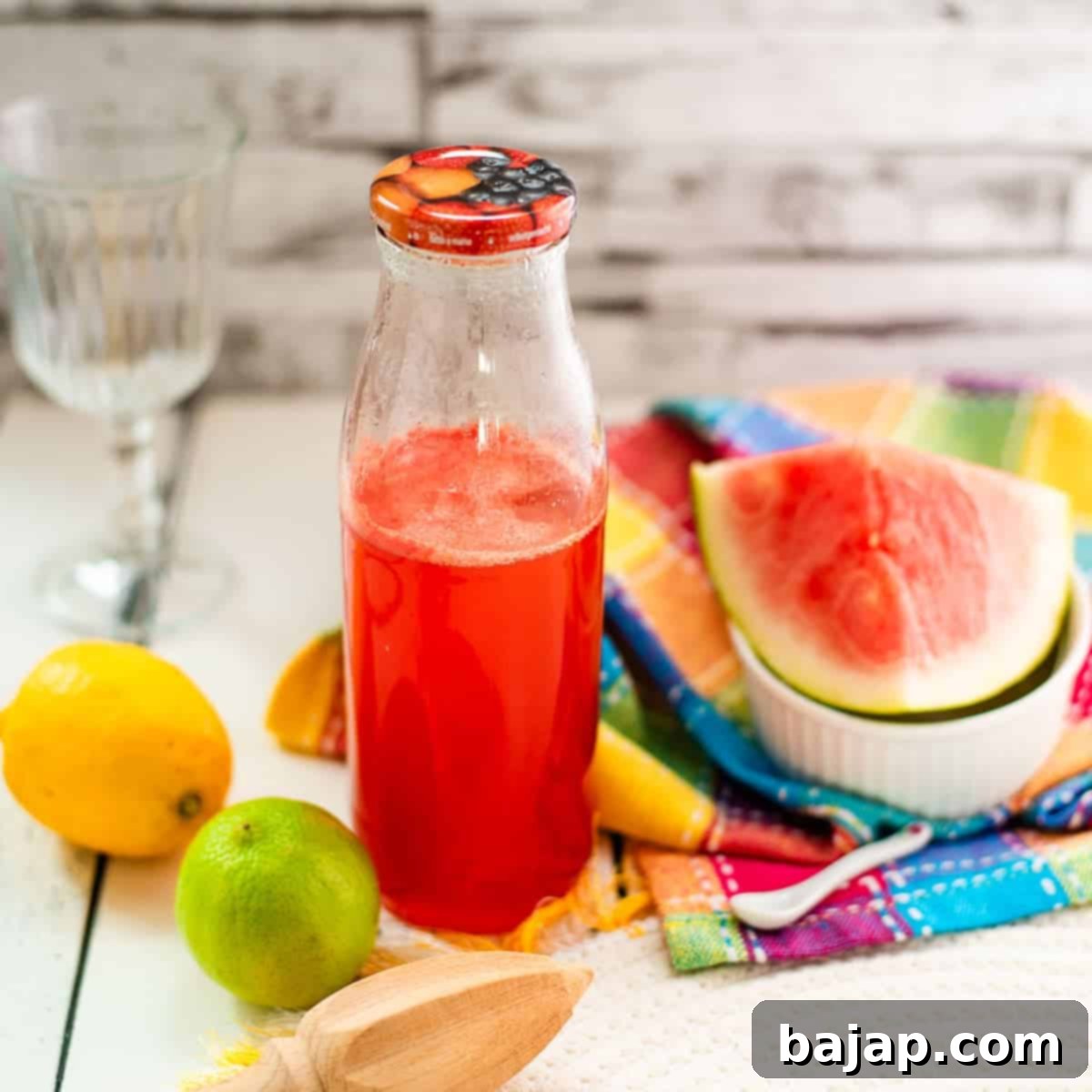Homemade Watermelon Syrup: Easy Recipes for Refreshing Summer Drinks & Desserts
Welcome to the peak of watermelon season! This luscious, hydrating fruit is at its absolute best during the sunny months of June, July, and August. What better way to capture its vibrant essence and sweet flavor than by transforming it into a versatile homemade watermelon syrup? Say goodbye to artificial flavors and embrace the pure, natural taste of summer in a bottle.
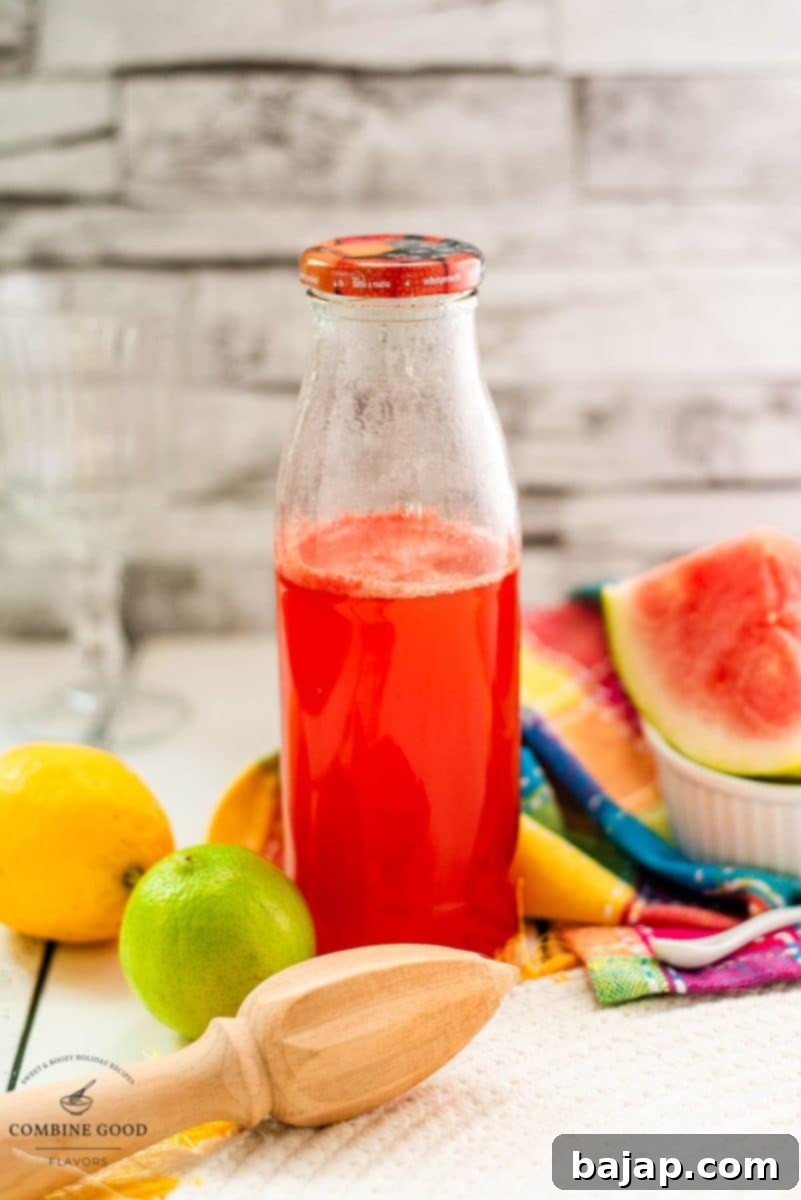
Watermelon syrup is far more than just a mixer for fancy cocktails or refreshing non-alcoholic drinks. Its delicate sweetness and beautiful hue make it an incredibly versatile ingredient that can elevate a wide array of culinary creations. Imagine it drizzled over creamy scoops of homemade ice cream, incorporated into a light summer dessert, or even used to add a unique twist to glazes and marinades. The possibilities are truly boundless.
And the best part? It’s incredibly easy to make right in your own kitchen! We’re excited to show you two simple yet effective methods for crafting this delightful watermelon-infused syrup: a traditional boiling method for a slightly longer shelf life and a quick, no-boil alternative that retains maximum fresh flavor. Both will yield a vibrant, delicious syrup perfect for sweetening your summer. Let’s dive in and make the most of this bountiful watermelon season together – your taste buds are in for a treat!
Why Craft Your Own Watermelon Syrup at Home?
While store shelves might offer various syrups, nothing quite compares to the purity and flavor of a homemade batch. Here are compelling reasons to make your own:
- Pure, Authentic Flavor: Commercial syrups often rely on artificial flavors and colors. Your homemade version will taste like real, ripe watermelon – a difference you can truly savor.
- Control Over Ingredients: You choose the quality of your watermelon and control the amount of sugar, allowing for a healthier and more customized product. You can even experiment with organic ingredients.
- Zero Unwanted Additives: No preservatives, high-fructose corn syrup, or obscure chemicals. Just natural fruit, sugar, citrus, and water.
- Cost-Effective Preservation: When watermelons are abundant and affordable, making syrup is an excellent way to preserve their seasonal goodness for months to come, saving you money in the long run.
- Impressive Versatility: Having a bottle of homemade watermelon syrup on hand opens up a world of culinary possibilities, from simple drinks to gourmet desserts, and even savory applications.
- The Joy of DIY: There’s immense satisfaction in creating something delicious from scratch, knowing exactly what goes into it.
🥘 Essential Ingredients for Watermelon Syrup
Crafting this refreshing homemade watermelon syrup requires only a handful of readily available ingredients. The key to the best flavor lies in selecting a perfectly ripe watermelon. Here’s what you’ll need, along with a few tips for each component:
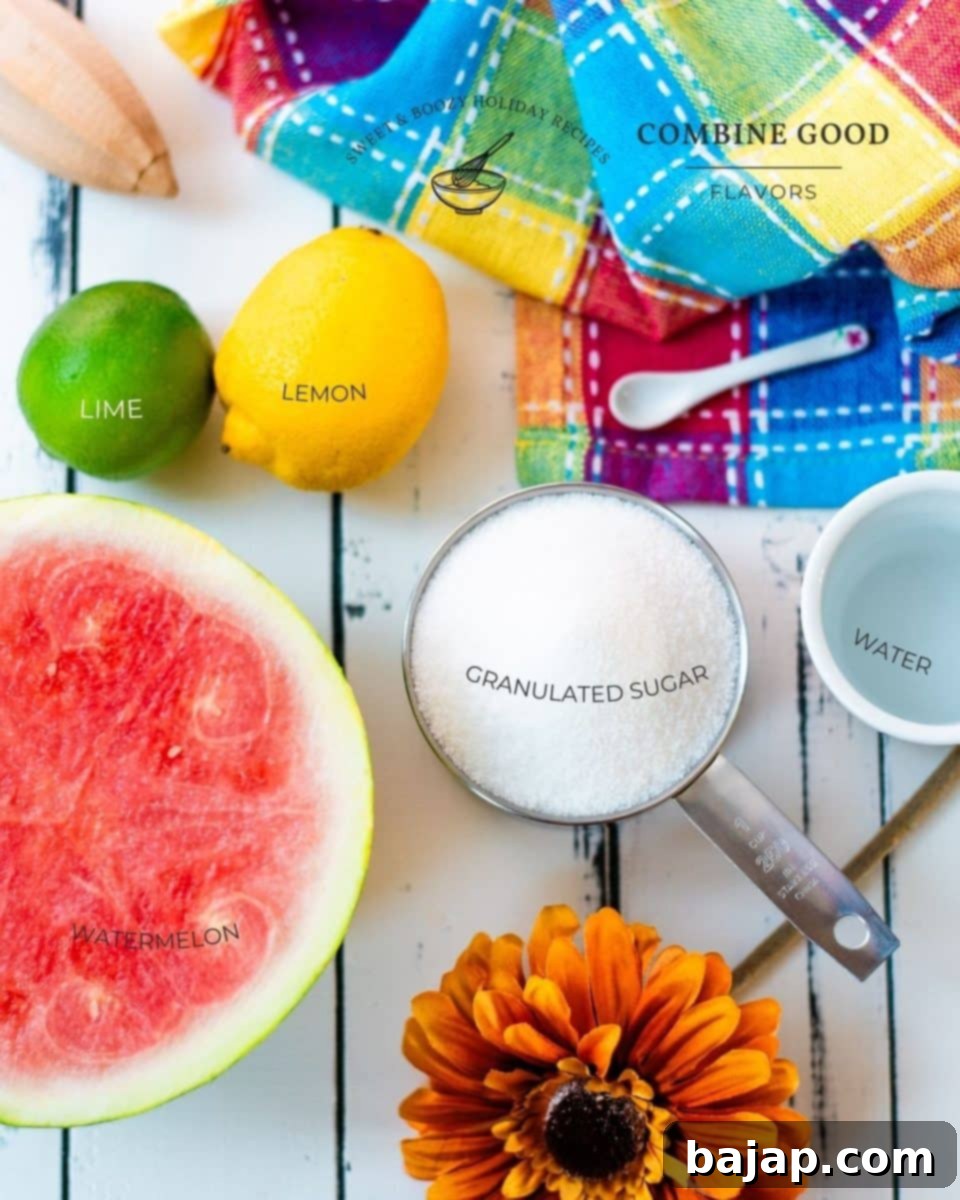
- ½ pound / 250 g Watermelon (fruit) – The undeniable star of our recipe. Prioritize a very ripe, sweet, and if possible, seedless watermelon. Ripe fruit ensures maximum natural sweetness and intense watermelon flavor. If your watermelon has seeds, dedicate time to removing them thoroughly; this prevents any bitterness from seeping into your syrup and ensures a smooth texture.
- ½ pound / 250 g White granulated sugar – This is not just for sweetness; sugar plays a critical role in the texture and preservation of your syrup. It dissolves to create the syrupy consistency and acts as a natural preservative, extending the shelf life. You can slightly adjust the amount to suit your preferred sweetness level, but be mindful that significant reductions might affect preservation.
- 4 ½ tablespoon / 65 ml Water – A small amount of water is added to help dissolve the granulated sugar more effectively, especially in the boiling method, and to help achieve the ideal syrup consistency.
- 2 tablespoon / 30 ml Lime juice (freshly squeezed) – This ingredient adds a crucial tangy, bright, and slightly aromatic citrus note that beautifully complements and cuts through the sweetness of the watermelon. Beyond flavor, the acidity from the lime juice acts as a natural preservative and helps prevent sugar crystallization, ensuring a smooth syrup. Freshly squeezed juice is paramount for the best, most vibrant flavor.
- 2 tablespoon / 30 ml Lemon juice (freshly squeezed) – Similar to lime juice, fresh lemon juice introduces another layer of zesty acidity and a slightly different citrus aroma. It works in harmony with the lime to balance the overall sweetness, brightening the watermelon flavor and further aiding in the syrup’s preservation.
🔪 Watermelon Syrup – Method with Boiling (The Classic Approach)
This traditional method involves gently simmering the ingredients, which helps fully dissolve the sugar, slightly concentrates the flavors, and results in a syrup with a more extended refrigerator shelf life.
Step 1: Prepare the Watermelon.
Carefully remove the thick green rind from your watermelon. Once the rind is off, cut the pink flesh into large, manageable chunks. If your watermelon contains seeds, meticulously remove them all. The easiest way to do this is often by hand or with the tip of a spoon. Removing seeds is crucial to avoid any undesirable bitterness or textural imperfections in your finished syrup. Once deseeded, cut the watermelon flesh into smaller, uniform pieces, which will facilitate easier pureeing in the next step.
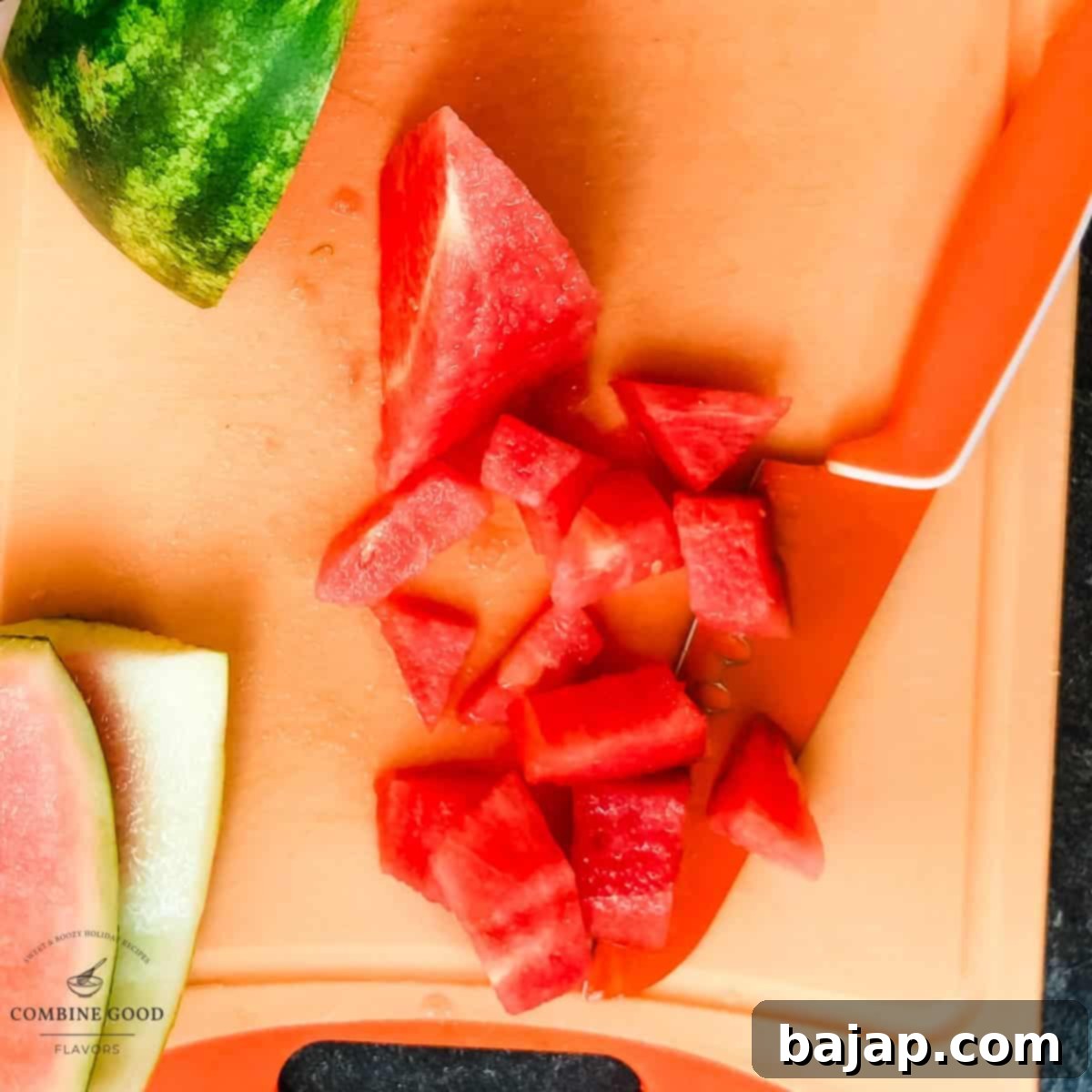
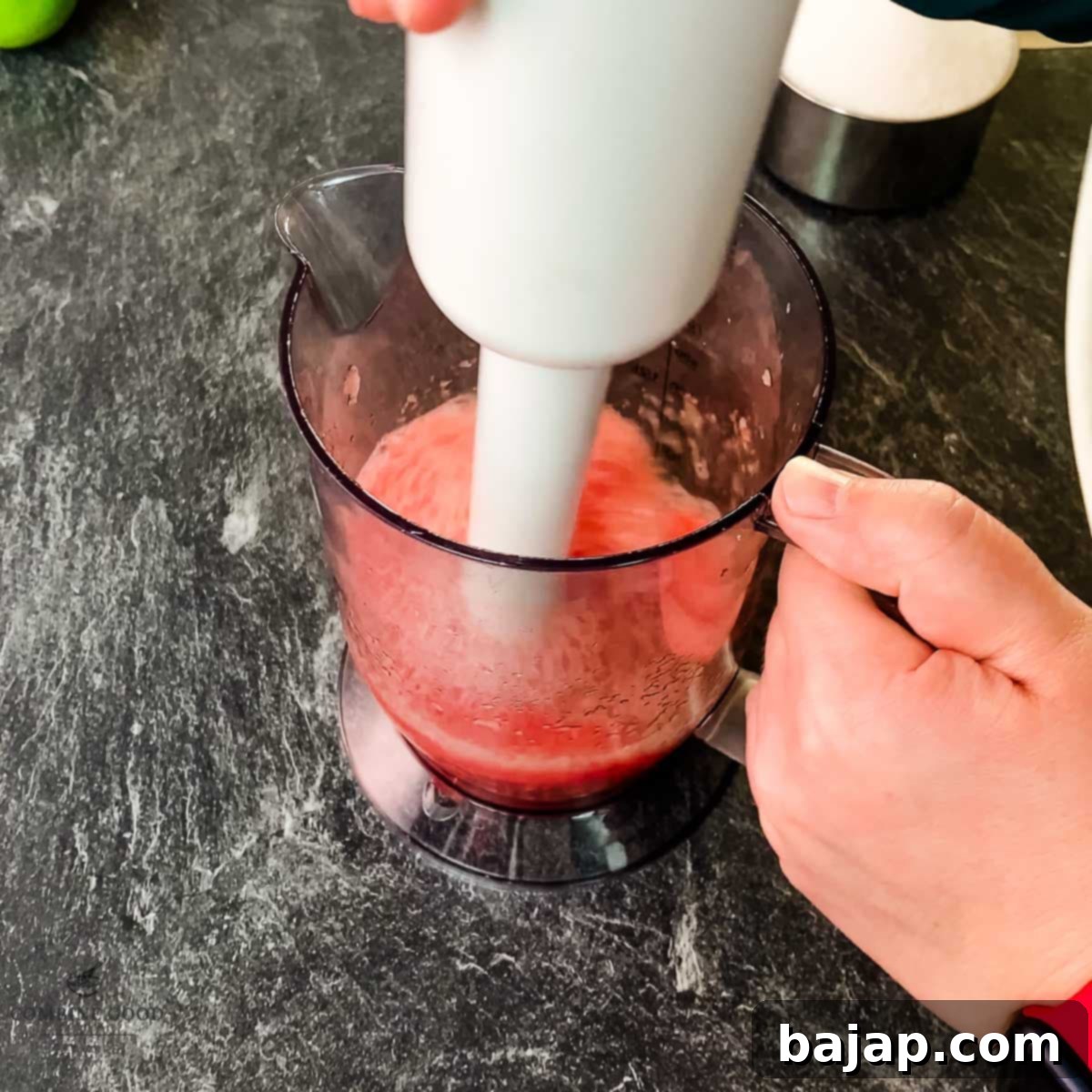
Step 2: Puree the Watermelon to a Fine Consistency.
Transfer all the prepared watermelon pieces into a tall container, such as a large measuring cup or a blender pitcher. Using a hand blender (also known as an immersion blender), finely puree the melon until it achieves a perfectly smooth, liquid consistency. Alternatively, you can use a standard blender or food processor. Blend until no discernible chunks remain, ensuring the mixture is as uniform as possible for the next step.
Step 3: Strain the Puree for a Crystal-Clear Syrup.
For a truly smooth and clear watermelon syrup, it’s essential to remove any pulp or fibrous bits. Place a fine-mesh sieve over a clean saucepan. Pour the puréed watermelon through the sieve. Use the back of a sturdy spoon or a rubber spatula to press firmly against the pulp in the sieve, extracting as much liquid as possible. Continue pressing and stirring the pulp until only dry, fibrous material remains in the sieve. This straining step is key to a refined, professional-looking syrup.
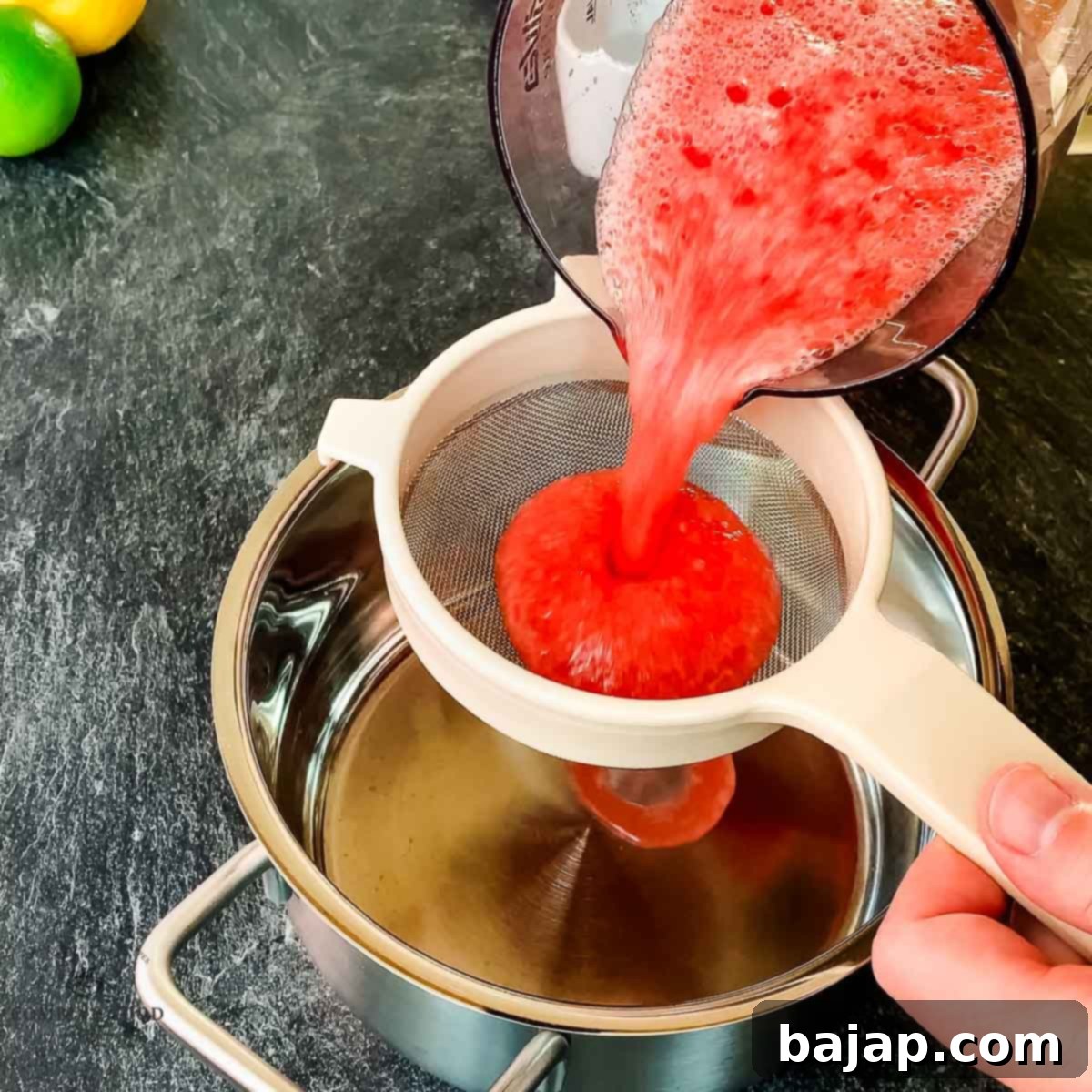
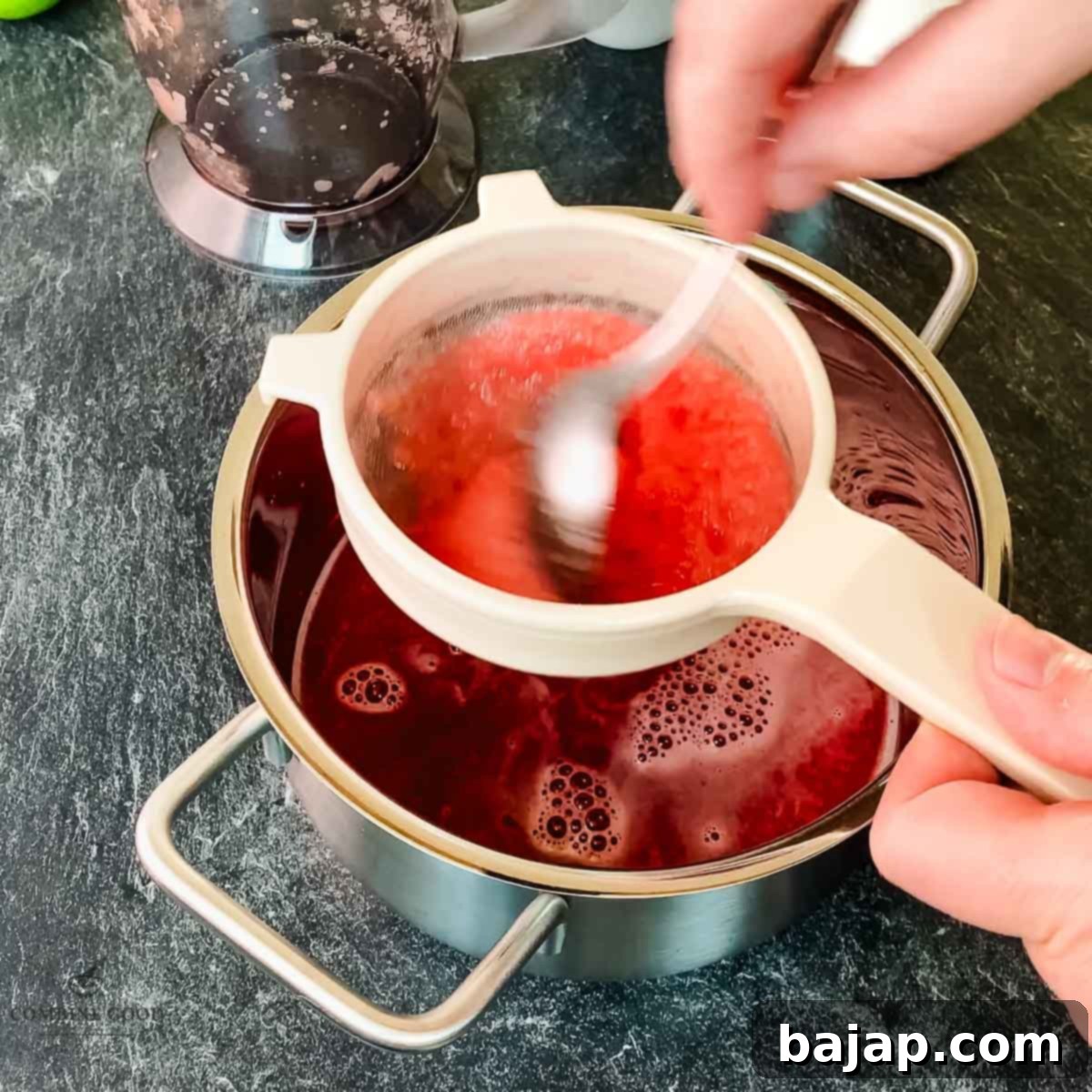
Step 4: Combine Remaining Ingredients and Simmer.
To the saucepan containing your freshly strained watermelon juice, add the measured water, the freshly squeezed lemon juice, the freshly squeezed lime juice, and the granulated sugar. Stir all these ingredients together thoroughly with a wooden spoon until the sugar begins to dissolve into the liquid. Place the saucepan over medium heat and bring the mixture to a gentle boil, ensuring it doesn’t boil over. Once boiling, reduce the heat to a low simmer and let it cook for approximately 5 minutes, stirring occasionally to prevent sticking and ensure even dissolution of the sugar. This simmering time allows the flavors to meld beautifully, the sugar to fully integrate, and the syrup to achieve a slightly thicker, more syrupy consistency. Avoid over-boiling, as this can diminish the fresh watermelon flavor.
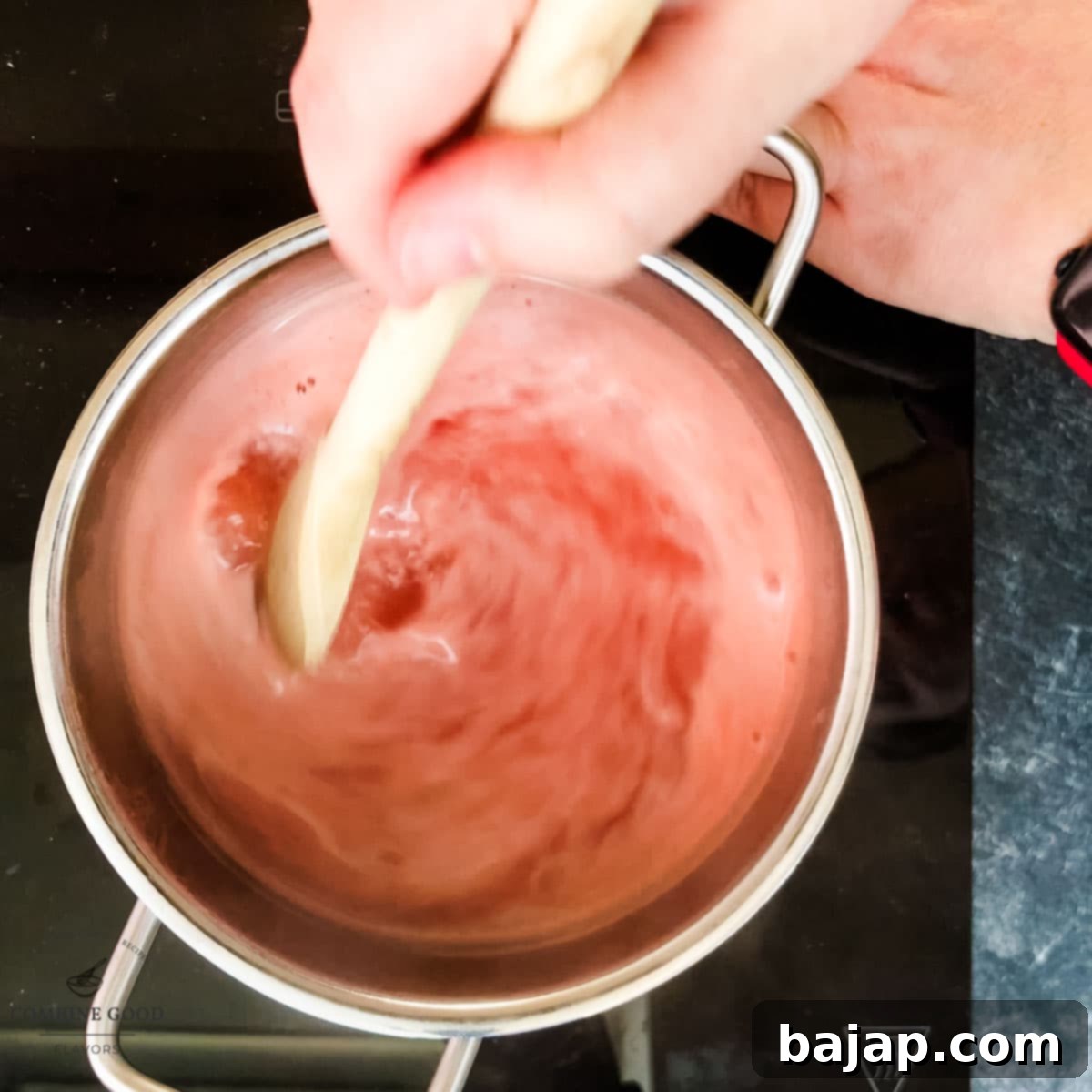
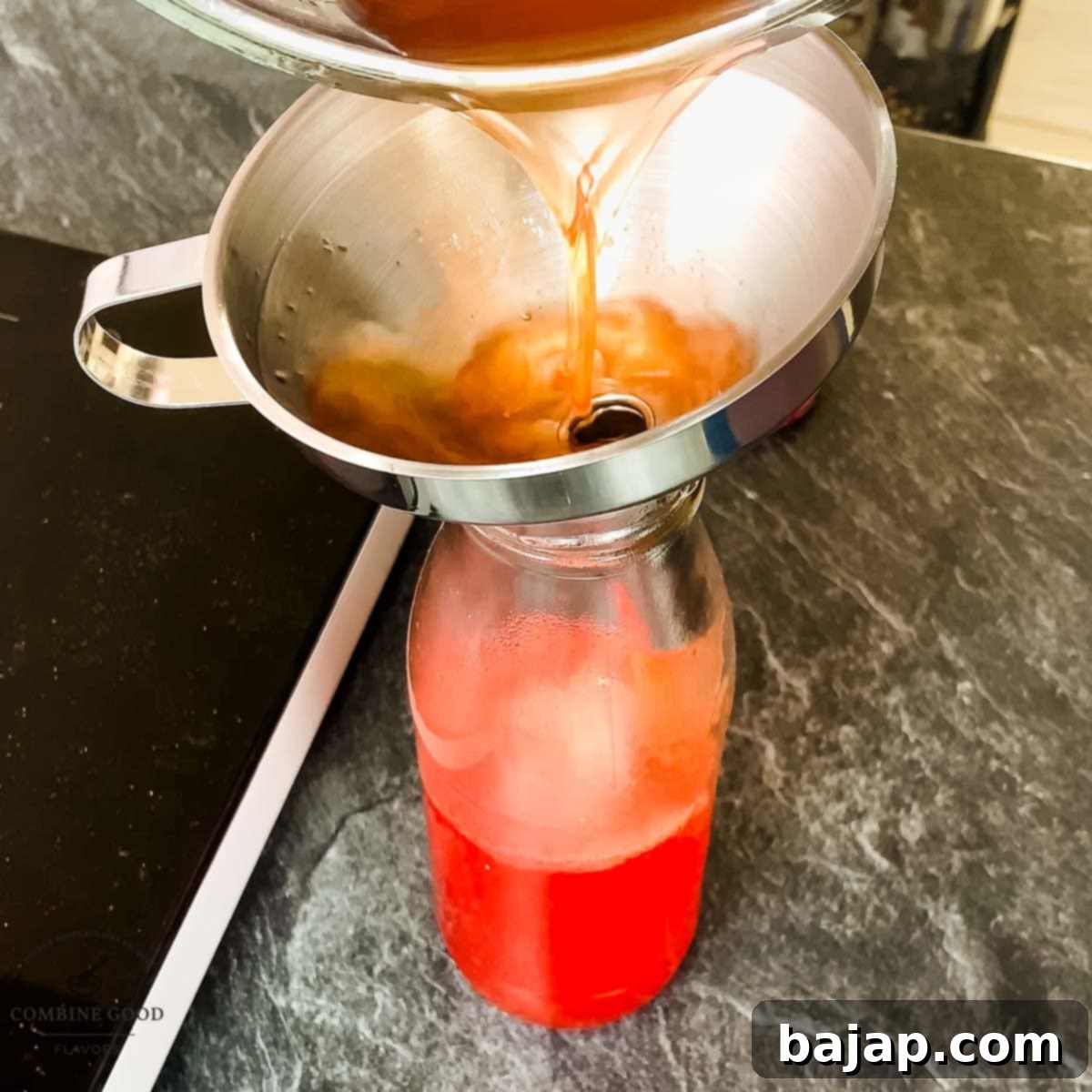
Step 5: Bottle and Seal Immediately.
Once the syrup has finished simmering, remove the saucepan from the heat. Immediately and with extreme caution, pour the hot watermelon syrup into your pre-sterilized glass bottles or jars. Use a funnel to ensure a neat transfer and prevent any spills, which can be dangerous with hot liquids. Fill the containers almost to the top, leaving a small headspace. Seal the bottles tightly with their corresponding lids. The heat of the syrup, combined with the sterile containers, helps create a vacuum seal as the syrup cools, which is crucial for extending its shelf life.
Step 6: Cool and Store for Longevity.
Allow the sealed bottles of watermelon syrup to cool completely to room temperature on your countertop. Avoid disturbing them during this process. Once fully cooled, transfer the bottles to your refrigerator for long-term storage. Storing the syrup in a cool, dark place like the fridge will ensure maximum freshness, preserve its vibrant color, and extend its shelf life for several months.
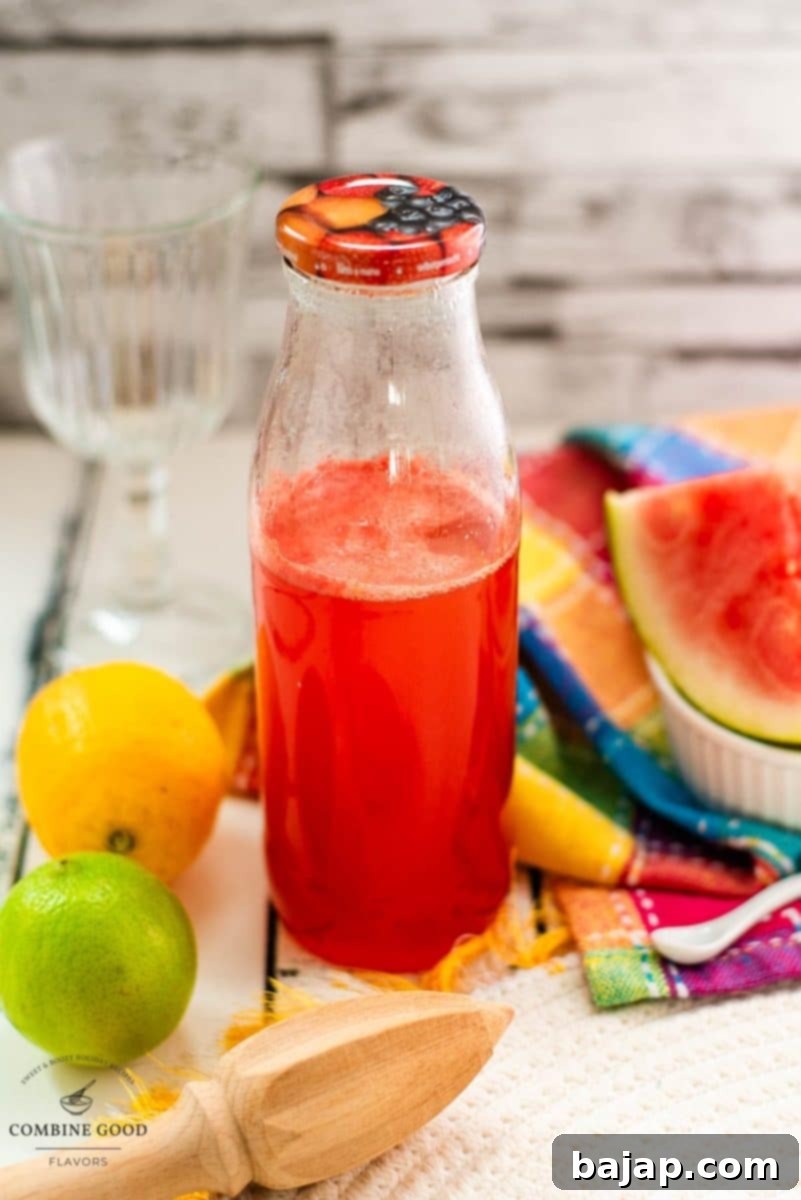
🔪 Watermelon Syrup – Alternate Method without Boiling (The Fresh & Easy Way)
If you prefer a raw, intensely fresh watermelon flavor and a quicker, less hands-on approach, the no-boil method is a fantastic choice. It preserves more of the delicate fruit enzymes and vitamins.
Step 1: Muddle Watermelon and Combine with Ingredients.
First, prepare your watermelon by removing the rind and any seeds, then cutting the flesh into small pieces. Place these watermelon pieces into a clean, sturdy preserving jar or a deep mixing bowl. Using a muddler (a bar tool typically used for cocktails), gently but firmly crush the watermelon pieces. This action releases their natural juices and maximizes the surface area for sugar dissolution. Once muddled, add the remaining ingredients to the jar: water, fresh lemon juice, fresh lime juice, and granulated sugar. Stir all the components thoroughly until they are well combined.
Step 2: Natural Infusion and Sugar Dissolution.
Seal the preserving jar tightly with its lid. Place the jar in the refrigerator and allow the mixture to sit undisturbed for a minimum of 24 hours. During this period, the sugar will naturally dissolve into the watermelon and citrus juices, creating a vibrant, flavorful syrup through a process of osmosis. For optimal results and to speed up the dissolution, give the jar a gentle shake or stir a few times over the 24-hour period.
Step 3: Strain for Immediate Enjoyment.
After the 24-hour infusion period, remove the preserving jar from the fridge. Place a fine-mesh sieve over a clean bowl or directly over your final storage bottle. Pour the entire contents of the preserving jar through the sieve, again pressing down on any solids with the back of a spoon to extract every last drop of the precious liquid. Discard the remaining pulp. Your vibrant, unboiled watermelon syrup is now ready to use! This method truly shines in its ability to deliver an exceptionally fresh and bright watermelon taste.
I highly recommend trying both methods to discover which one best suits your preferences! Each offers a slightly different nuance in flavor profile and syrup consistency.
🍋 Creative Substitutions & Flavor Variations
One of the true joys of homemade syrups is the freedom to customize and experiment with flavors. Here are some ideas to make your watermelon syrup truly unique:
- Citrus Flexibility: While lemon and lime offer a fantastic balance, feel free to adjust to your taste. You can use either lime juice or lemon juice exclusively if you prefer a single citrus note. For an intriguing twist, try a splash of fresh grapefruit juice for a slightly more bitter, sophisticated edge, or swap in orange juice for added sweetness and a different aromatic profile.
- Herbal Infusions: Elevate the complexity of your syrup by adding fresh herbs. A few sprigs of mint, basil, or even a couple of thin slices of fresh ginger can be added during the simmering process (for the boiled method) or allowed to infuse with the watermelon in the no-boil method. Remember to strain them out before bottling for a clean, smooth syrup.
- Subtle Spice: For an unexpected warmth and depth, consider adding a tiny pinch of freshly ground black pepper, a sliver of jalapeño (remove seeds for less heat), or a couple of cardamom pods. These can create a delightful contrast to the sweet fruit.
- Alternative Sweeteners: If you wish to reduce refined sugar, you can experiment with natural alternatives like honey, maple syrup, or agave nectar. Be aware that these will slightly alter the syrup’s flavor and color, and may affect the final consistency and shelf life. Adjust amounts to taste.
- Berry Boost: Combine watermelon with other complementary summer fruits. A handful of fresh strawberries, raspberries, or even cherries can be pureed along with the watermelon for a multi-layered berry-watermelon syrup that is exceptionally delicious.
- Floral Notes: A few drops of rosewater or orange blossom water can add a delicate, exotic floral aroma. Add these sparingly after the syrup has cooled.
🌡️ Storage & Maximizing Shelf Life
Proper storage is paramount for preserving the freshness, flavor, and safety of your homemade watermelon syrup. Since it contains fresh fruit juices, refrigeration is non-negotiable.
- Boiled Method Storage: When prepared using the boiling method, poured into thoroughly sterilized jars while hot, and sealed immediately, your homemade watermelon syrup can boast an impressive shelf life. Expect it to remain fresh and delicious for approximately 3-4 months when continuously stored in the refrigerator. Always ensure the lid is tightly sealed after each use to prevent contamination.
- No-Boil Method Storage: Due to the absence of a heating step, the no-boil syrup has a slightly shorter, but still respectable, shelf life. It will typically last for about 2-3 weeks in the refrigerator. The utmost cleanliness during preparation and the freshness of your initial ingredients will significantly impact this duration.
- Freezing for Long-Term: For extended preservation, homemade watermelon syrup freezes beautifully! Pour the cooled syrup into ice cube trays and freeze until solid. Once frozen, transfer the syrup cubes to a freezer-safe bag or airtight container. Frozen watermelon syrup can last for 6-8 months, offering a taste of summer even in the depths of winter. Thaw individual cubes or larger portions as needed.
- Vigilant for Spoilage: Always practice caution. Before each use, visually inspect your syrup for any signs of spoilage, such as mold growth, cloudiness, off-odors, or unusual discoloration. If you notice any of these indicators, or if there’s any doubt about its freshness, it’s always best to discard the syrup.
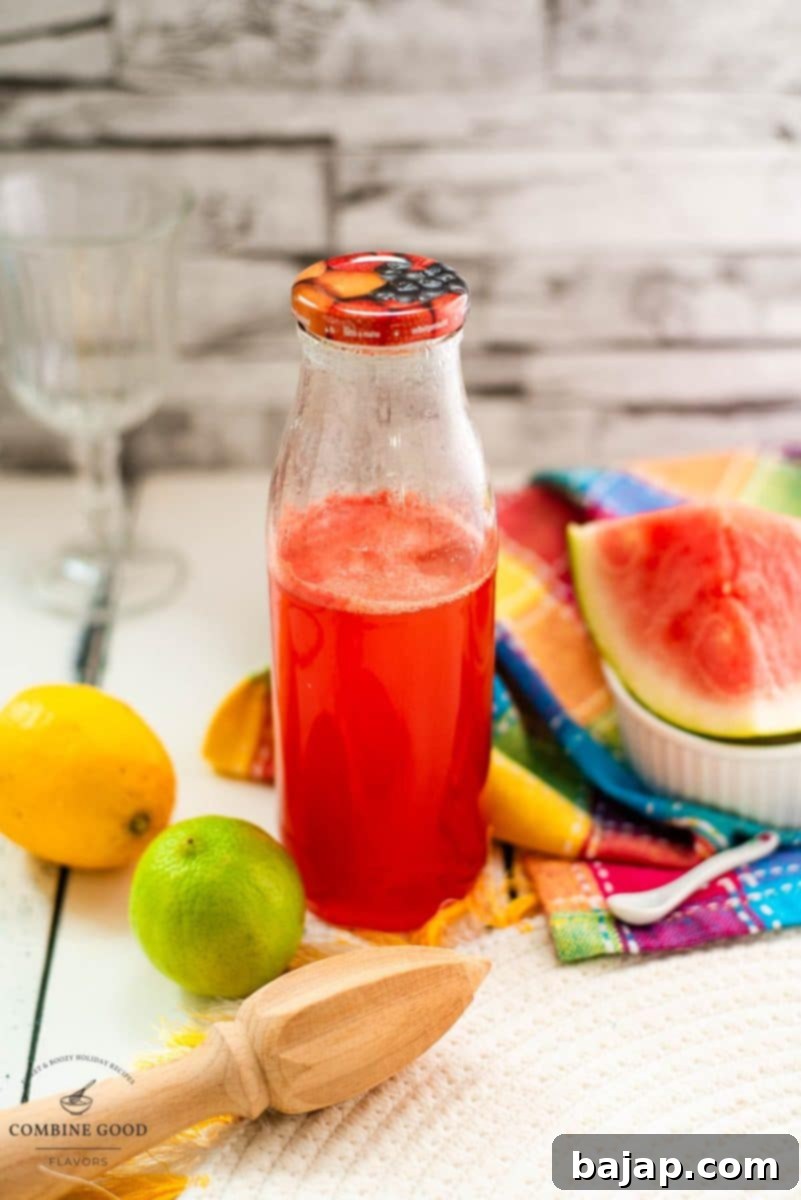
🍽 Essential Equipment for Perfect Watermelon Syrup
Having the right tools at hand will make your syrup-making process both efficient and enjoyable. Here’s a list of the equipment you’ll need, along with a brief explanation of its purpose:
- Tall container: This is ideal for pureeing the watermelon, as its high sides prevent splashes and keep your kitchen clean, particularly when using an immersion blender.
- Immersion blender: A fantastic tool for quickly and thoroughly pureeing the watermelon directly in its container. Its ease of use and cleanup make it a favorite. (A standard blender or food processor can be used as an alternative).
- Saucepan (Small): Necessary for the boiling method, ensure it’s large enough to hold the watermelon juice and other ingredients without overflowing during simmering.
- Spoon and Wooden Spoon: A regular spoon is useful for de-seeding watermelon and pressing pulp. A wooden spoon is great for stirring the syrup in the hot saucepan, as it doesn’t conduct heat as quickly as metal.
- Close-Meshed Sieve: Absolutely crucial for achieving a smooth, pulp-free syrup. This step filters out any fibrous bits from the watermelon, resulting in a professional texture.
- Funnel: An invaluable aid for safely and cleanly pouring the hot (or cold) syrup into narrow-necked bottles without spills.
- Muddler – Essential for the alternate no-boil method. It allows you to gently yet effectively crush the watermelon to release its juices, which then dissolve the sugar over time.
- Airtight Glass Containers (Sterilized): For hygienic and effective storage of your finished homemade syrup. Sterilizing these containers is a critical step for food safety and maximizing the shelf life of your syrup, especially when using the boiling method.
💭 Expert Tips for the Best Watermelon Syrup
- Always Start with Ripe Watermelons: The overall success and flavor intensity of your syrup are directly linked to the quality of your watermelon. Always select the ripest, sweetest watermelon you can find.
- The “Thump” Test: Gently tap the watermelon with your knuckles. A ripe watermelon will emit a deep, hollow sound, indicating that it is full of water and perfectly ripe. Avoid those that sound dull or flat, as they may be under-ripe or over-ripe.
- Weight Indicates Ripeness: A ripe watermelon should feel surprisingly heavy for its size. This density is a good sign that it’s packed with juice and natural sugars.
- Look for the Field Spot: Check the underside of the watermelon for a creamy yellow or even orange-yellow spot. This “field spot” is where the watermelon rested on the ground and indicates it spent ample time ripening on the vine, developing full flavor. A white or greenish spot means it was picked too early.
- Consider Seedless Watermelon for Convenience: While not a strict requirement, opting for a seedless watermelon can significantly speed up your preparation process. You’ll save time by not having to meticulously remove all the tiny seeds, making your syrup even faster and easier to make.
- Repurpose the Watermelon Pulp: Don’t discard the flavorful pulp left in the sieve after straining! This concentrated watermelon essence can be a delicious addition to smoothies, blended into yogurt, stirred into overnight oats, or even frozen into refreshing ice pops. Minimize waste and maximize flavor!
- Adjust Sweetness to Taste: The natural sweetness of watermelons can vary. Before adding all the sugar, taste your pureed watermelon. If your fruit is exceptionally sweet, you might slightly reduce the amount of granulated sugar. Conversely, if it’s less sweet, you might add a touch more until it meets your preference.
How to Sterilize Glass Containers (A Critical Step for Preservation)
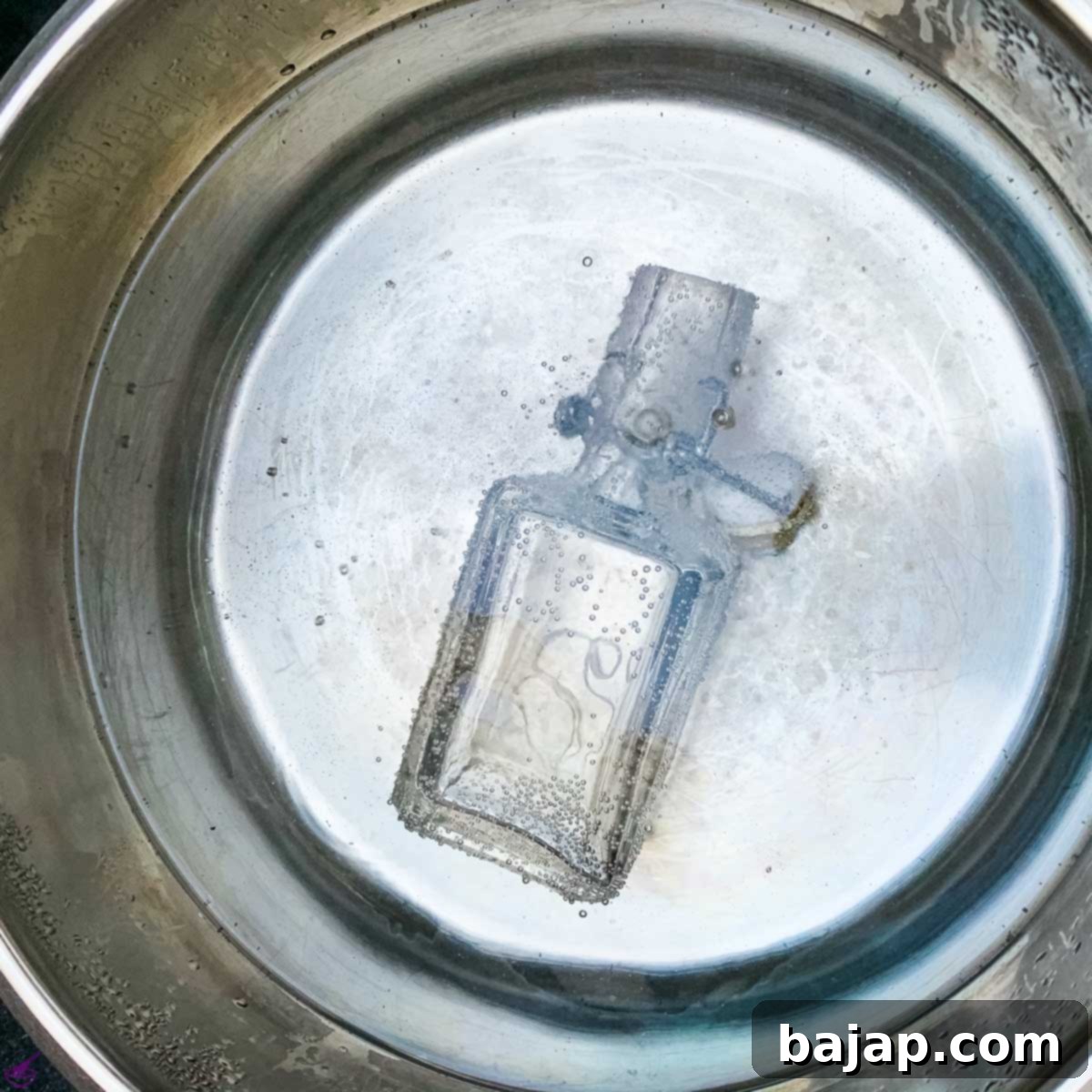
Sterilizing your glass containers is an absolutely vital step, particularly when using the boiled syrup method, as it significantly extends the syrup’s shelf life and ensures food safety by eliminating harmful bacteria and microorganisms. Here’s a simple and effective method:
- Pre-Wash Thoroughly: Begin by washing your glass jars, bottles, and their lids (if they are metal, ensure they are boil-safe) thoroughly with hot, soapy water. Rinse them meticulously to remove all soap residue.
- Prepare a Hot Water Bath: Find a large pot that can accommodate all your containers, ensuring they can be fully submerged. Carefully place the clean jars, bottles, and lids into the pot. Fill the pot with water, making sure all items are covered by at least an inch of water.
- Boil for Sterilization: Bring the water to a rolling boil over high heat. Once the water is vigorously boiling, reduce the heat slightly to maintain a steady boil. Allow the containers to boil for a minimum of 10-15 minutes. This sufficient boiling time effectively sterilizes the glass.
- Careful Removal and Drying: Using sterilized tongs (which you can sterilize by boiling them alongside the jars), carefully remove each item from the hot water. Place them upside down on a clean, freshly laundered kitchen towel or a wire rack lined with paper towels to air dry completely. It’s crucial not to wipe them, as this can reintroduce contaminants. Ideally, fill them with your hot syrup while they are still warm to prevent thermal shock (cracking) and maintain their sterility.
Delightful Serving Suggestions for Watermelon Syrup
Once you’ve successfully crafted your homemade watermelon syrup, a world of flavorful possibilities opens up! Its sweet, refreshing profile makes it a star ingredient in a multitude of culinary applications. Get ready to impress with these creative serving suggestions:
- Irresistible Refreshing Drinks:
- Sophisticated Cocktails: This syrup is a dream mixer for various spirits. Create an unforgettable watermelon margarita with tequila, a zesty watermelon mojito with rum and fresh mint, or a simple yet elegant vodka soda with a generous splash of syrup. It also pairs wonderfully with gin.
- Sparkling Mocktails & Lemonades: For a non-alcoholic treat, mix the syrup with sparkling water, tonic water, or homemade lemonade. Garnish with fresh mint, lime slices, or a small watermelon wedge for an extra touch of flair.
- Iced Tea Sweetener: Stir a tablespoon or two into freshly brewed iced black, green, or even hibiscus tea. It adds a natural sweetness and a beautiful fruity undertone.
- Smoothies & Fresh Juices: Boost the flavor and sweetness of your morning smoothie, fresh fruit juice blends, or even vegetable-fruit concoctions. It’s especially good with cucumber or ginger.
- Sweet Treats & Decadent Desserts:
- Ice Cream & Sorbet Topping: Drizzle generously over vanilla ice cream, refreshing lemon sorbet, or creamy frozen yogurt for an instant gourmet upgrade.
- Pancakes, Waffles, & French Toast: Move beyond maple syrup! Watermelon syrup offers a delightful, fruity alternative to classic breakfast toppings.
- Yogurt & Oatmeal Enhancer: Stir into plain Greek yogurt, overnight oats, or a warm bowl of oatmeal for natural sweetness and a burst of summer flavor.
- Elevated Fruit Salads: Gently toss your fresh fruit salad (think berries, melon, kiwi) with a light coating of watermelon syrup. It adds shine and an extra layer of sweetness.
- Baking Applications: Incorporate the syrup into glazes for Bundt cakes or cupcakes, use it as a simple soak for sponge cakes, or even infuse whipped cream with it.
- Granitas & Shaved Ice: Create a simple granita by freezing diluted syrup and scraping it with a fork for a light, icy dessert.
- Savory Pairings (Unexpectedly Delicious!):
- Vinaigrette Twist: A subtle hint of watermelon syrup can add an intriguing sweetness to a vinaigrette, particularly one destined for a salad featuring feta cheese, mint, and cucumber.
- Light Marinades: Use a small amount in marinades for grilled chicken, pork tenderloin, or even white fish. The fruit sugars caramelize beautifully, and the flavor complements savory notes surprisingly well.
More Refreshing Recipes for Your Summer Adventures
- Mini Blueberry Pavlova – A light, airy dessert with fresh berries.
- Coconut Pound Cake – A tropical twist on a classic.
- No-bake Lemon Cheesecake – Cool and tangy, perfect for hot days.
- Homemade Vanilla Ice Cream – The perfect canvas for your watermelon syrup!
–> Discover even more Delicious Summer Recipes to brighten your season!
If you give this homemade watermelon syrup recipe a try, please let me know how you enjoyed it by leaving a ★★★★★ star rating and a comment below. Your feedback is invaluable to us! You can also sign up for our Newsletter to receive weekly delicious homemade recipes, or follow me on Pinterest or Instagram and share your delightful creations with me. Just tag me @combinegoodflavors and use the hashtag #combinegoodflavors, so I don’t miss your culinary masterpieces!
📖 Recipe Card: Homemade Watermelon Syrup
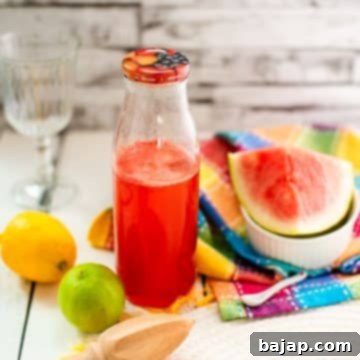
Watermelon Syrup Recipe
By Nora
Save RecipeSaved!
Pin Recipe
Equipment
-
Tall container
-
Immersion blender
-
Saucepan small
-
Wooden spoon
-
Spoon
-
Close meshed sieve
-
Funnel
-
Muddler for the alternate version without boiling
-
Airtight Glass Container Sterilized
